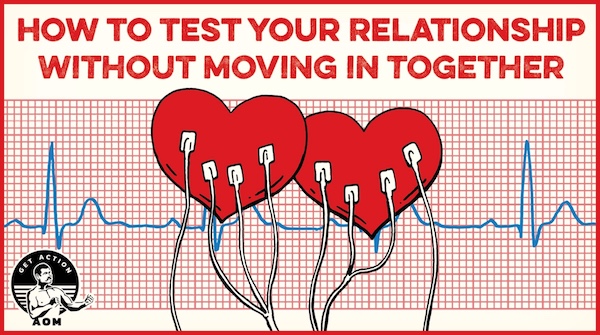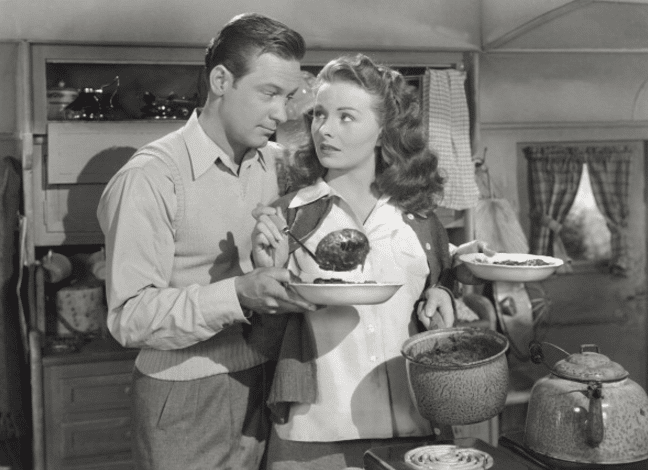Over the last few decades, it’s become more and more common for couples to move in together while they’re dating. They often opt for this living arrangement because it feels convenient, and also because they want to “test” the relationship before deciding whether or not to get married. Couples figure that by experiencing what it’s like to live in close proximity and do day-to-day routines together, they can make a better decision about their compatibility and long-term prospects, in order to avoid someday getting a divorce.
While the idea makes a great deal of sense in the abstract, numerous research studies have definitively shown that living together before marriage does not reduce a couple’s chances of divorce. At all. How can that be?
There are likely a few factors at play, but a big one is that those who cohabitate often end up sliding further into their relationship, rather than deliberating deciding to make progressively deepening commitments. They just kind of slide into living together with a casual “Why not?” feeling; then slide into staying together out of a sense of comfort and complacency; and then slide into getting married, figuring, “Well, we’ve been together this long; I guess this is the next step to take.” In living together, their lives — pets, bills, friends, routines — get so intertwined that it becomes easier to stick with the arrangement — even if the relationship is less than ideal — than to break things off. They may therefore ultimately marry someone out of sheer familiarity, rather than ardent love. “Do you, Rob, take Sunk Cost Fallacy to be your lawfully wedded wife?”
It seems that whatever positive benefit comes from getting to know someone by way of living with them, it is outweighed by the danger of staying together because of inertia rather than brilliant connection.
Are there then other ways to “test” the strength of your relationship, without at the same time significantly increasing the difficulty of breaking up? To make a better-informed decision about your future with someone, while still maintaining more of your independence before you do?
Fortunately, there are. To get some ideas on this front, I talked to Dr. Scott Stanley, a professor of psychology at the University of Denver, who coined the “sliding vs. deciding” paradigm, and has spent his career researching cohabitation, relationships, and commitment.
How to Test Your Relationship Without Moving in Together
Really, “testing” isn’t the best word here; if you’re in a mindset where you’re literally wanting to test a relationship, you probably already have doubts about it, which probably means it’s already on shaky grounds, and actively putting it on trial, so to speak, is probably going to make things worse.
We’re using “test” here not as an encouragement to pin down your relationship for dissection — snuffing out its life in the process — but simply as a way of deepening and expanding the natural course of getting to know someone. To take the relationship out of confined, greenhouse-like conditions and expose it to more elements. Testing your relationship shouldn’t be about placing it under a cynical, hypercritical microscope, but simply being more explorative — seeing if, as a couple, you’re suited for tackling life’s great adventure together.
To that end, below you’ll find ways of turning over more rocks in your relationship, so you can observe what you find there — whether red flags or endearing qualities — and gain a greater perspective as to who your partner really is.
1. Interact With Your Respective Friends and Family
Stanley observes that when two people start dating, they can often cordon themselves off into an isolated bubble. This may be especially true in the age of dating apps, where the relationship may not grow out of a preexistent, shared social scene; rather, two discrete individuals, perhaps new to a city and lacking a real friend or family group, pair up through the digital ether. They then spend all their time one-on-one, only interacting with each other. But engaging exclusively within a dyadic, romantic, chemistry-driven context will only elicit a relatively narrow range of behaviors, giving each partner a limited view of one another. As Stanley explained to me:
Let’s say two people meet online, they’re communicating, they’re messaging a lot, and then maybe they start having a lot of phone calls, and then they’re dating, and they’re spending every moment together. That’s all great. But there’s a lot of things you don’t learn about a person when you don’t see how they treat other people. Yeah, they’re excited about you. They’re sexually attracted to you. [But] they’re not always gonna be as sexually attracted to you, so how do they treat people that are just people that are important in their life? Because that might be how you’re gonna get treated.
Observing how your girlfriend interacts with her friends, and your friends; her family, and your family; is going to offer a lot more insight into who she really is, than just how she interacts with you. So resist the cliché of being that couple who gets so into each other, that they ghost everyone else in their lives.
It is arguably especially important to see how your girlfriend engages with her own family. Being back with the people she grew up with will often trigger behaviors she may otherwise be good at keeping under control around you. As a satirical headline on The Onion hilariously put it: Woman Nervous for Boyfriend to Meet the Person She Becomes Around Parents.
Of course, how someone treats their family may not be indicative of exactly how she’ll treat you (people have particular hang-ups with family members that are largely context specific), but there will invariably be broad, underlying patterns in her behavior towards them that will almost certainly manifest themselves in your relationship as well.
2. Interact in a Wide Variety of Situations
Building on the point above, new(ish) couples often only see each other in a limited range of structured, sort of scripted situations — going to dinner, going to the movies, watching tv at each other’s apartments, etc. These predictable scenarios produce fairly predictable sets of behavior.
To get to know someone to a greater extent, it’s helpful to see how she personally handles the unexpected — how she deals with stress and being outside her comfort zone — and the extent to which you are able to work through curveballs together.
So don’t just stick to a “climate controlled” circuit of dating life; go camping, do a service project, attend a worship service, and so on together. Navigate new kinds of experiences and interact with different types of people.
The fact that the longer you’re in a relationship, the more and more varied situations you’ll end up in as a couple, is part of the reason Stanley recommends taking your time when dating someone and not rushing into things.
3. Get Clear on Your Values and Expectations
Two people don’t have to be clones of each other to make a good go at marriage, but sharing core values certainly increases a couple’s chances of lasting happiness, while conflicts in these areas become highly corrosive over time.
Conversations about your values, beliefs, and expectations for your future life together should begin fairly early in a relationship, obviously getting progressively deeper and more detailed as it becomes clearer that a future together is a realistic possibility.
Is religion important to you? Where do you want to live? Do you want to live near your parents? Would you move for your job? Do you want to have kids? How dedicated are you to your career? Would you have a problem with me working long hours or being on the road a lot? Do you believe in budgeting? What’s your spending philosophy?
On the topic of having kids — which can become a big sticking point for married couples — Stanley said: “You can’t believe the number of marriage counselors” who’ve worked with couples where “they’re struggling over this very issue and they’ve been married for a few years and they knew it beforehand or they didn’t know it. Either way, it’s like you guys could’ve talked about this.”
Realize there are a couple of limitations to these value-uncovering conversations, however.
First, even if you’re talking about your beliefs and expectations, the high-inducing, mind-altering chemistry of love can lead partners to gloss over differences that arise. They’re so giddy, that the potential source of conflict doesn’t seem like that big a deal; “love conquers all,” they think, or they figure their partner will change their mind on that issue once they’re hitched. But people rarely change their core values and beliefs.
Because the cocktail of love is so heady, it’s important to know — to be radically clear — on what your non-negotiables are before you get in a relationship; then once you fall head over heels, your old self can hopefully talk some sense into your punch-drunk self.
The second caveat, is that while it can be helpful to talk about hypotheticals, it’s hard from the position of the present to know with surety the decisions you’ll actually make in the future.
It’s thus important not only to listen to what your significant other says, but to also watch what she does. She’s of course not going to act out in the present every scenario you may face in the future, but her behavior in various situations will reveal her real values — the underlying beliefs that may not be able to predict exactly what decisions she’ll make down the road, but will give you an idea of what direction she, and your shared lives, will go.
4. Travel Together
Travel could be filed under “Interact in a Wide Variety of Situations”; it will certainly often help you see how your significant other handles new people and places and deals with unexpected curveballs. But travel deserves its own entry because it also includes a unique relationship-testing element of its own: planning. Plotting out a significant trip takes some real effort and is a good chance to see how you work together as a team — if you’re able to sacrifice and compromise and communicate. As Stanley observed, it’s a chance you might not otherwise get before you’re prepping to walk down the aisle:
You probably would learn some things in traveling with the person, but you might learn a whole lot in planning to travel with the person. Because planning’s a big thing in life. And a lot of couples actually don’t get into a serious mode of developing a plan together until it’s their wedding. And that’s a pretty weird, intense thing to sort of practice on.
5. Do Premarital Training/Counseling
Taking a premarital preparation/counseling course isn’t something to just mindlessly check off to fulfill a minister’s requirement for officiating your wedding, or to get a discount on a marriage license. Earnestly engaging in such a program can help facilitate the key value-disclosing discussions described above, identify potential issues and disagreements, and teach relationship-strengthening tools. As Stanley argues here:
While marital experts debate everything, there is solid evidence that completing premarital training (education, counseling, whatever it’s called) together can improve your odds in marriage. Although this does not guarantee marital bliss, there is much more potential upside than downside. The one downside I sometimes think about is actually an upside: you could learn something concerning about your partner or relationship that you didn’t fully appreciate before — something that could lead you to get more help or go slower. Because of this, I recommend that you seek premarital training as far before a wedding date as possible. Why? Because the further in advance you complete it, the more you have a chance to find out something that could lead you to change your mind about marrying each other.
Premarital preparation courses are available in the form of church-sponsored events and local workshops. If you don’t know of one, ask a marriage counselor/therapist for a recommendation. While doing an in-person workshop will help keep you accountable, if you’re dedicated to working through the process, you can also try reading a marriage prep book or doing an online program together; Stanley recommends this one, this one, and this one (he’s involved with the latter).
For more insights on the harms of “sliding vs. deciding” and the importance of seeking clarity over ambiguity in relationships, be sure to listen to my podcast with Dr. Stanley:
Tags: Dating







